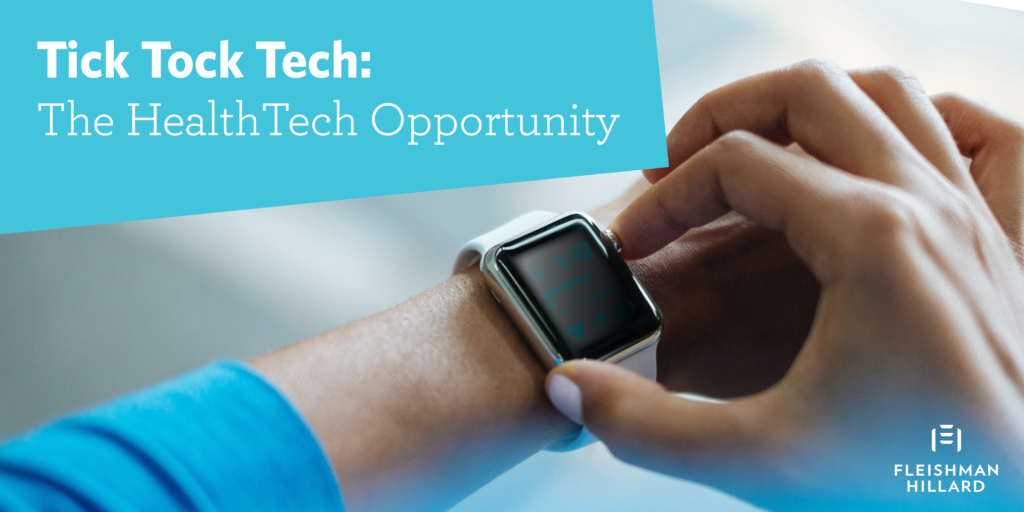Tick Tock Tech: The HealthTech Opportunity
It goes without saying that technology has enhanced healthcare systems and practices around the world. New tools and solutions have impacted every point in the patient experience, from sharing health records to early detection and noninvasive procedures, improving the way healthcare professionals approach diagnosis and treatment. We even saw a decline in preventable illness and death, significant reductions in treatment and recovery time and an overall improvement of patient well-being. However, the COVID-19 pandemic showed us that despite these countless advances, there is still a lot of untapped opportunity.
Increased demand during the pandemic led to new records in 2021 for venture capital (VC)-backed healthcare funding, investments and exits. In the U.S., total VC funding in the healthcare sector rose to $29.1, nearly doubling 2020’s record, across 729 deals. At the end of last year, there were 42 new HealthTech unicorns around the world collectively valued at $154B+.
With heightened competition for awareness and dollars, credibility is key. Creating news moments from investment rounds, sizable customer wins, partnerships and end-user use cases will bring stories to life and propel future company growth. There is so much new health technology and so much of it is hyped. True thought leadership, rather than product-led promotion, is a good way to get the attention of time-poor decision-makers. With strong research-based training, many healthcare leaders are very interested in learning from peers. Organizing events with their peers is another great way to build credibility.
Here are some of the biggest categories that are on the rise and where we see the story – and communications opportunity – evolving quickly:
- Telehealth Innovation: Digital health accelerated during the pandemic, with some healthcare leaders saying they saw a decade’s worth of innovation occur in months. Telemedicine, or telehealth as it is often known in Europe, continues to be a priority for healthcare leaders and is increasingly welcomed by patients. The move to virtual care outside of hospitals and medical offices will continue to expand healthcare access, which has the potential benefit of making the entire system more inclusive. It can also shorten hospital stays allowing greater efficiencies for healthcare providers. At the same time, doctor-to-doctor telehealth is also improving access to care, beaming specialist expertise into smaller, rural facilities that cannot usually support these specialists on the ground. Virtual care in settings like pharmacies and community centers, at-home care and remote expertise in clinics is here to stay and technology innovations will continue to improve remote patient diagnosis and treatments. Wearable devices and advances in drug delivery and apps will drive greater engagement.
- HealthTech Tools: Going in-hand with the rise of telemedicine, more wearable sensors and devices are being developed and are propelling investments. Employers are increasingly embracing mobile health tools for enhanced employee benefits, including mental health services, diet and lifestyle coaching, digital pharmacies and more. Consumer wellness applications have broad appeal by offering services like weight loss, at-home workouts, physical therapy and even in-home care for seniors and children.
- Predictive analytics and AI: We are in the early stages of the adoption of AI in healthcare, but with the right guidance and regulation in place, this technology offers huge potential. We are increasingly seeing healthcare providers use automated, prescriptive analytics to help improve the operational side of their facilities and to aid treatment. One area of AI to watch is digital twins that monitor, simulate and streamline data from devices. In healthcare, twins are largely used for modeling and prediction. For example, by integrating different measurements from a patient over time, and linking these biophysical models, it is possible to build a personalized digital model of a heart that doctors can then use to model different outcomes very accurately, ultimately improving treatment for that patient, often with fewer invasive treatments.
- Better data integration: As with most technologies, those highlighted above are underpinned by data. Unlocking siloed data to enable safe, secure sharing beyond the walls of a single hospital is a priority for hospitals and medical offices globally. It can make diagnosing a patient much more efficient, but it’s also important on the operational side. The pandemic has exacerbated staff shortages within healthcare. Giving healthcare staff easier access to data is one way of removing the administrative burden that takes up so much time for most healthcare professionals – time that could be spent treating patients.
We are still in the early stages of the digital health revolution. The pandemic was just the kickstart needed to propel attention and investor dollars in the sector. There is significant advancement and opportunity in health, especially relative to the GDP it consumes: healthcare is a $4 trillion sector of the U.S. economy, accounting for roughly 20% of the U.S. GDP. The UK healthcare market is projected to reach $1,951.7 million within the next four years – an annual growth rate of 6.4%. Like many industries, HealthTech companies globally are trying to appeal to talent who can help accelerate their businesses. A key benefit: The sector tends to appeal to mission-driven technologists who want to make a difference in the world and impact millions of people.
This is an exciting space, and we cannot wait to see how things develop.
We’ll see you next month when we will explore the intersection of tech and consumer lifestyle.

